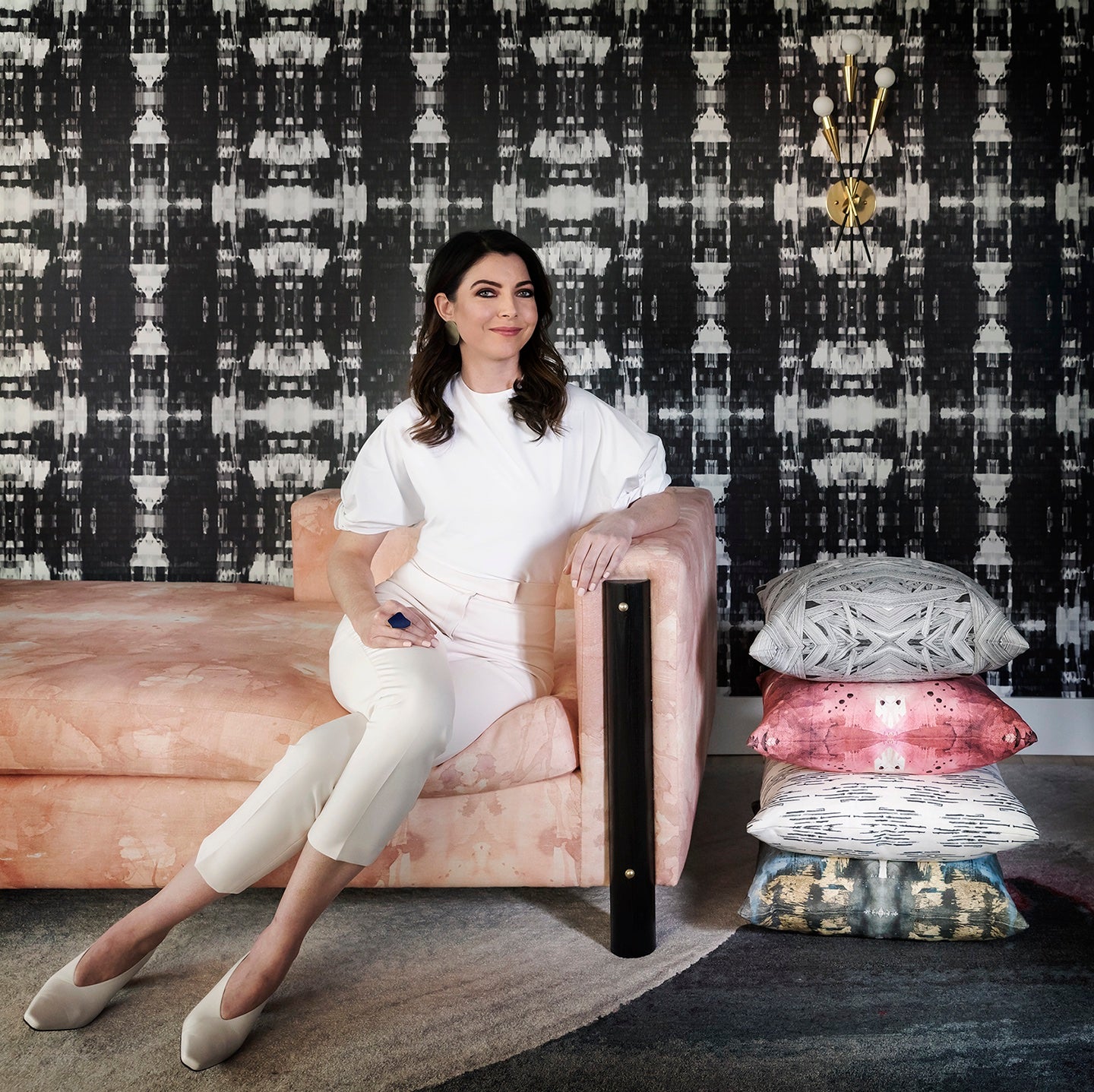The 50 States Project is a yearlong series of candid conversations with interior designers across the country about how they’ve built their businesses. This week, Seattle-based designer Michelle Dirkse tells us about the top SEO lessons she has used to fuel her business, why her ideal projects are “weird in a good way,” and how team trips have become part of her firm’s culture.
What are your earliest memories of being drawn to design?
My earliest memory is of having Strawberry Shortcake curtains and wanting to tie them back. I wanted to kind of swag either one to the left and right with hair ties, but I only had one, so I had a choice: I either could have my hair look cute for kindergarten, or I could swag back my curtains. And I remember being 5 or 6 and telling myself, “This is ridiculous. No one’s going to see your curtains.” I don’t remember where I landed, but I remember caring more about the curtains than my hair. In high school, I took a lot of photography classes, and music and woodshop. And then at home, I was always kind of like, “How can we make something work? How can I turn this into what I really want?”
You went in a different direction professionally, though.
I didn’t really consider it an option to have a design career. I was also really drawn to the idea of helping people. If I have to work, I might as well do a job that’s helping others. So I went to school for psychology, and when I first graduated, I did social work with chronically mentally ill adults—the “chronic” means that they don’t ever get better, and it’s really hard. Then I worked with kids in schools, and that was hard, but better.
When did you start thinking about pivoting?
I bought a condo during that time and had the freedom to remodel and paint it. I was like, “I love design. Why don’t I go take a couple classes?” So I did. And from there, I was like, “Well, I can always go back to social work if this doesn’t work out.”
Was it pretty clear once you started taking design classes that this was it?
For sure. It was an intro class, and it was really fun to have a reason for what I kind of naturally wanted to do. Like learning triadic color theory and realizing that’s why I think these colors that all my friends think shouldn’t go together magically go together. I started working at furniture showrooms while I was in school, because I felt like I was behind [in] changing careers—I worked at Kreiss, and then at Roche Bobois. Then for one summer, I partnered with a friend and we flipped a house in the area I grew up in. I was doing work physically—with a sledgehammer, tearing out three chimneys and these deck or porch areas—and I could really see the process of construction, which was valuable later on.
After that, I worked at Waterworks, where I learned the ins and outs of how plumbing fixtures and tile layouts work. And then the recession happened, so I was picking up small things here and there—like drafting for a company that designed ice sculpture lands. I would call out the dimensions of the ice penguin and have to shop for a hat for the ice penguin—all kinds of weird things.
Eventually, I worked for an interior designer here in Seattle, and then for a construction company. It was at the construction company where I started to think about going out on my own. I realized that if I work harder, I want to benefit from that. I took a class at night to help with business planning, and then I left and I started serving at a restaurant. That was January 2013—I was serving part-time and had a couple clients—and then by November, I could take the plunge to [quit] the serving job. Soon, I was able to hire my first person, then my second. Each step felt so scary.
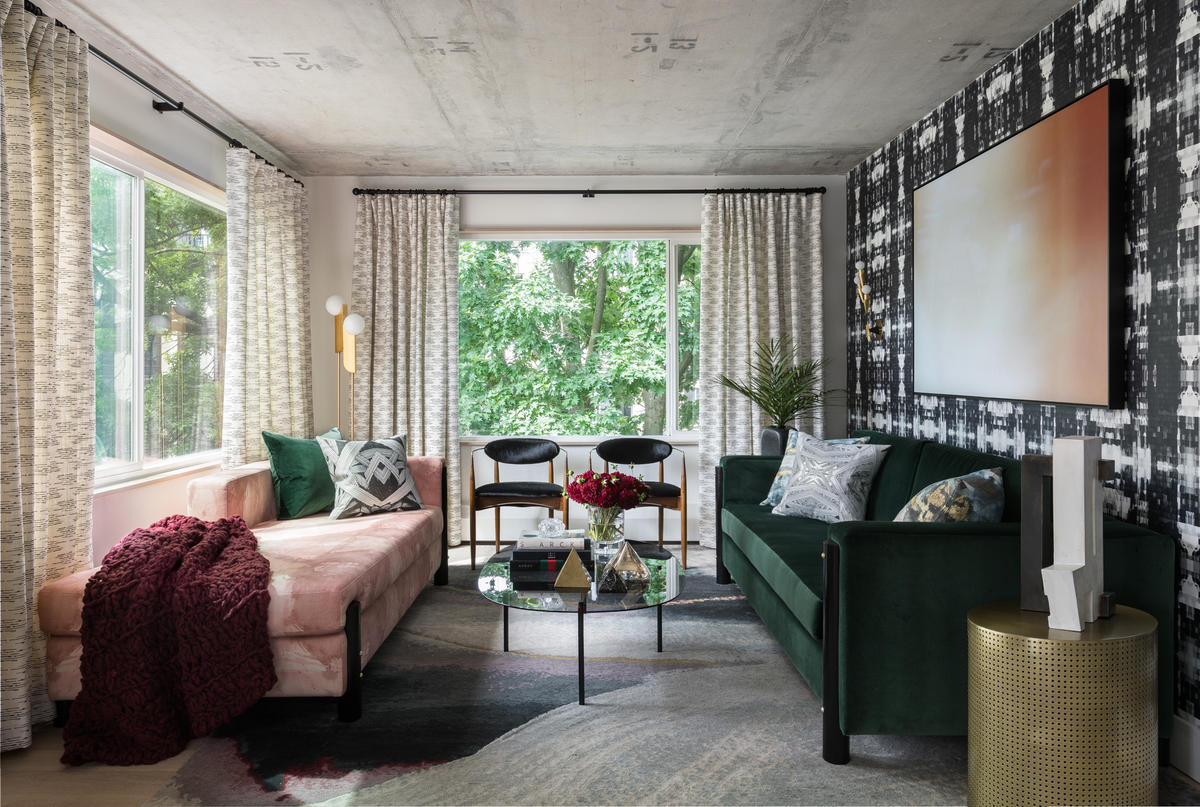
When did you make that first hire?
I think it was August or September 2014 when I hired my first full-time junior designer or design assistant. And then I hired an office person for a couple days a week, and then after another year, I hired another interior designer. So then the team was me plus two and a half. [Hiring new people] was like a one-a-year thing. But I also don’t want to do things twice—so if I’m coming up with a system for training, how do we document it and make it easy to replicate for the next person, and also a better experience for them? That became a priority.
How did you know you were ready to grow?
The first time [I hired someone] it was [because] I was on-site during the day so much that I couldn’t get the work done. To have meetings, check on construction, design, invoice and do all the ordering—I just couldn’t do it myself, so I needed help. I didn’t really know how it was going to work, but it did.
Where did the early clients come from?
Houzz! I had a free profile, and maybe 75 percent of clients came from there for the first year or two. Now, it’s about one-third repeat clients, either with a new project in the same home, or a new or vacation home. The rest are coming from SEO and Google search, which I’ve worked really hard on.
What does that require?
I’m so glad you asked, because I want everyone to know this. OK, some easy things: You want the internet to think you’re a real thing and give you as the answer when [people use search engines]. So how do you do that? One, register with Google Places; register with Bing; register with Yelp. The class I took even suggested being on LinkedIn. Once you’re registered, your name is tied to interior design, which helps. I also use Squarespace [for my website], and they have a tool where you just click a button and they’ll tell you how to label things differently to help your SEO results.
Another thing I learned about is cross-linking: If I link to a reputable site and that reputable site links to me, that tells search engines that I’m real. When I’m published in a magazine, sure, I put the picture [on my site], but I also link to the magazine. I’ve been on a local talk show a couple times and I haven’t gotten clients out of it, but the [talk show site] linked to me and then I linked to them, and it’s a big site.
I’ve also heard that search engines like video, so I do some YouTube, [even though it’s] maybe not 100 percent what I want for branding. So I hide a few YouTube links within my website. The viewer maybe wouldn’t know it’s there, but the search engine algorithm would. As long as it’s not going to hurt my website or branding, then I think it’s worth the try. You don’t [always] know which things are working, because if you did, then everyone would just do those things. So I’m just trying all the ones I know about.
And you’ve seen results?
Yes, for sure. If you Google “Seattle interior design,” I’m usually on the first page of results. I love when I get those emails from people like, “We can help you be on the first page of Google,” and I can reply, “I am.”

Is a client who comes from Google search a good client?
Not always, no. That was really burning me out last year. I was reaching out to other local designers [asking] what I should do, because I was spending two hours a day on calls with people I was pretty sure weren’t going to hire me because of budget. It’s a good problem to have, so I feel bratty complaining about it, but it was really exhausting. Other designers suggested having a minimum. They said, “Write up an autoreply and send it out [to everyone who inquires].” I had thought of doing that years earlier, but I felt like my firm wasn’t good enough at the time—like we hadn’t been around long enough to have that type of response. I thought I’d push people away. [But] it’s also not sustainable for me to talk to every single person, and [the minimum] pretty quickly weeds out [the wrong people]. Also, I want to work with a client that wants to work with us, not just anyone, and the minimum has been helpful for that.
What kinds of people are calling you now?
We’re getting clients who are coming to us because they’ve looked at our website and, whether it’s traditional or modern, they want something a little different. One client said it well when she was like, “I love things that aren’t what they seem.” I like that—how can I do that for your house? Another project we’re working on is a condo in a former church, and [the client] said that she wants it to be “less sanctuary and more mortuary.”
I can’t wait to see both of those.
I know, right? I want weird-in-a-good way projects. I’m at a place now where I can afford to take the risk of putting those projects as more of a focus on the website, instead of: “We can do everything—look at this Carrara marble and white Shaker cupboard house.” Yeah, I love doing that, but I don’t want to only do that. It’s nice to have a variety.
Have you been strategic about presenting your aesthetic to the world online?
At first, no. At first, I invested in photography. I researched which photographer works at local magazines or has provided photos to them, thinking, “OK, I’m probably able to get into this one. I have my best shot for my first publication with this one. I hired the photographer that they often hire so that he does it the way they like it.” I think that worked.
Is that still your approach?
Not as much. Now, I only photograph the projects that say something we haven’t already said on our website—which is kind of a bummer, because we do a lot of projects and I [only] photograph one-tenth of them.
Is that about what you think will have more appeal or attract new work, or is it just being selective about where you invest?
It’s being selective about where I invest, but also thinking about what I want to do more of. We just photographed a project that was kind of small, but I loved it. It was a midcentury modern house [with] almost dark or edgy modern elements. It ended up being interesting [to figure out] how to make those go together. We photographed that because it’s saying something different, and I want to have that on our website.
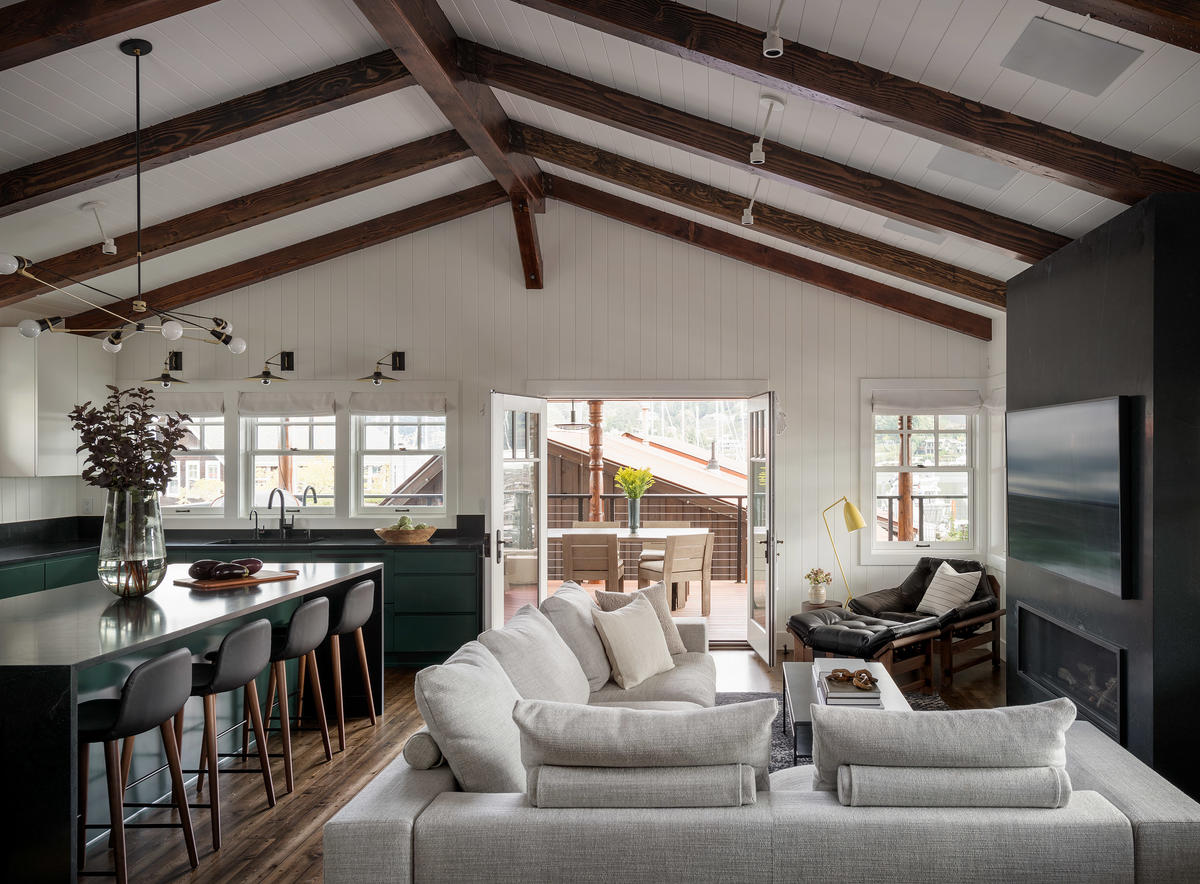
What does your team look like today?
I have a senior designer, an intermediate designer, a junior designer, an operations manager, and then me, so there are five of us. I never worked at a big firm, so I didn’t really have an example to follow. The way I structure it is that I’m working on every project, but I’m more like, “OK, let’s brainstorm together: They said this—what do they really mean? I think we should go in this direction. You take a shot at it based on this and what you think, and then let’s review again.” Each designer is also their own project manager. For bigger projects, the senior interior designer leans on the junior interior designer to help, but we’ve never had a project where the entire team is working on it.
How hands-on are you with every project?
Pretty hands-on, and I don’t know how to not be. That’s maybe one of my next challenges, because I still want [the vision] to be what I’m trying to make us. I’m at the client meetings. I’m on the client emails. I’m not on vendor emails. I see, approve and edit everything before the client does. Sometimes there are more or fewer things to do because when you’re working with the same people for so long, you start to think the same way.
How much do clients see you versus your team in the process?
Currently, they see me almost as much as the team because I’m at every design presentation. I’ve started to kind of back off when it’s a smaller follow-up presentation—maybe I won’t be there. I’m still afraid to do that. I maybe won’t go to every single construction site follow-up visit. Again, I’m still afraid to do that for every install. I’m there 80 to 90 percent of the time.
What are the things you’d never want to delegate?
The concept, especially now that I’m excited about every project we get. I don’t want to give that away. That’s the part I love. I don’t know how to grow bigger or if I ever want to, but if [the business] was bigger, maybe I would have two leads and review creative with them and let them guide it more. But right now, my name is on the door. I can’t yet—2013 wasn’t that long ago.
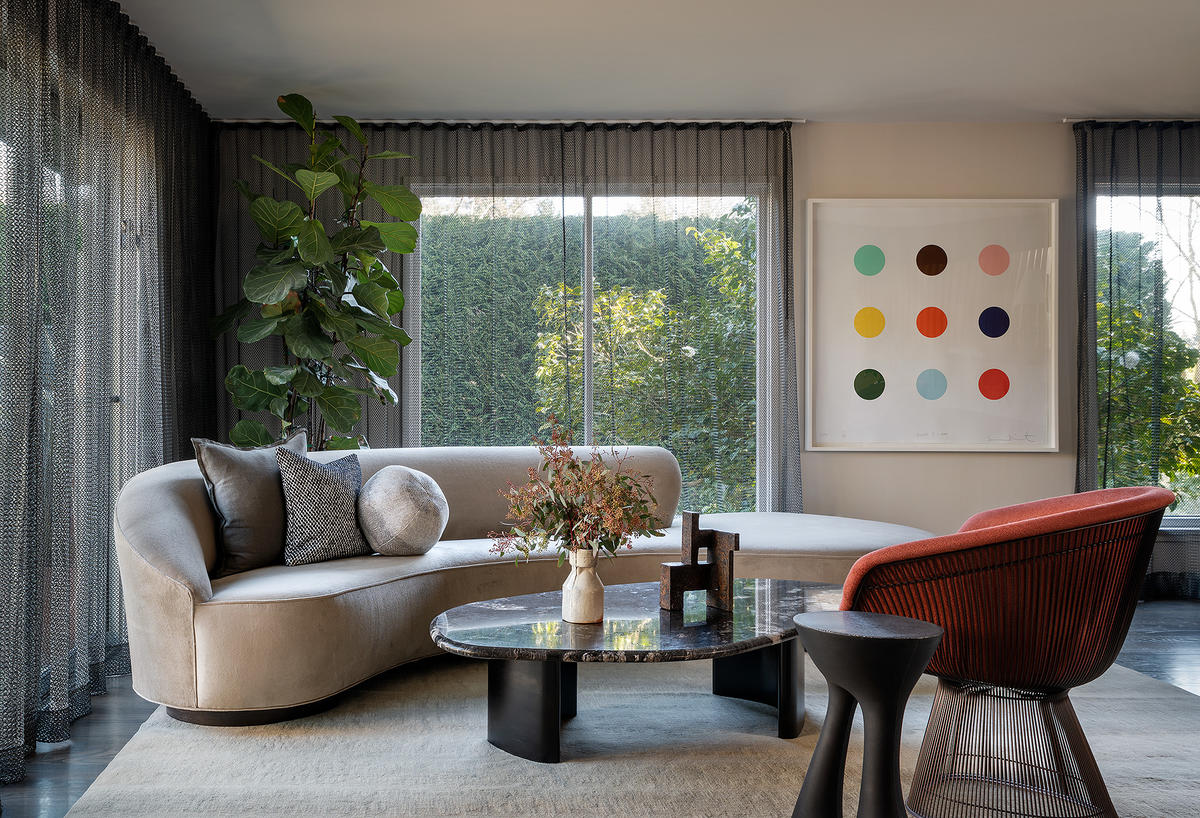
How many projects are you working on these days?
We have 23 open projects, including 10 major remodels plus furniture and decor, some that are just furniture and decor, and six that are wrapping up or on hold [because] we’re waiting for a contractor to be available. Or it’s [product delays], like, “OK, your two sofas that have been taking forever because of COVID are not here.”
Do you take one room at a time still, or the whole house?
I’m trying to stick to [whole houses], because design is a luxury and we charge a luxury price. We have a lot of efficient systems, but we’re humans. I can only be so efficient, and when I’m doing one room and I still have to do all of those steps, the design fee invoice feels disproportionate to the outcome for the client, and I don’t want to fight with clients. I’ll even explain it that way to potential clients, like: “You’re not going to feel like it’s worth it, even if you love it.”
Is that a new change?
Yes, I started that almost a year ago. Now, we have a minimum of $175,000, either for a furniture and decor purchasing budget or a remodel project budget. Remodel-wise, I basically can’t do anything for less than that unless it’s, like, a bathroom. Again, that comes back to the thing where my design fees are disproportionate per hour if I’m just doing a bathroom. And by having the audacity to say that, what client are you going to end up with? Someone who doesn’t think that’s a big deal, who hopefully isn’t going to argue with you about the time it takes for their project because it’s larger.
How has your relationship with clients changed as budgets get larger?
In general, I’m getting more clients that want what we do instead of just anyone. At first, I knew they just needed someone, and I was like, “Great, I will be that someone.” But if someone is coming to you for your work and selecting you because of it, there’s just a different respect there. I feel like they listen more.
What does growth look like to you?
I don’t know if growth looks like more team members right now. I think it looks like always having a waitlist and being really selective with our clients and getting more projects that are a little weird in a good way, and in different ways too, like something traditional but a bit different, versus modern. I don’t want to do the same thing over and over.
That’s a really hard thing to guarantee in some ways, because I feel like one project begets more projects that look like that project to some extent.
I’m surprised by what projects bring in other potential clients. With the sanctuary-becoming-mortuary project, they had seen our work on a historic home where that client said, “We want our home to look like a haunted mansion.” I’m like, “What is this niche that I’m becoming a part of?”
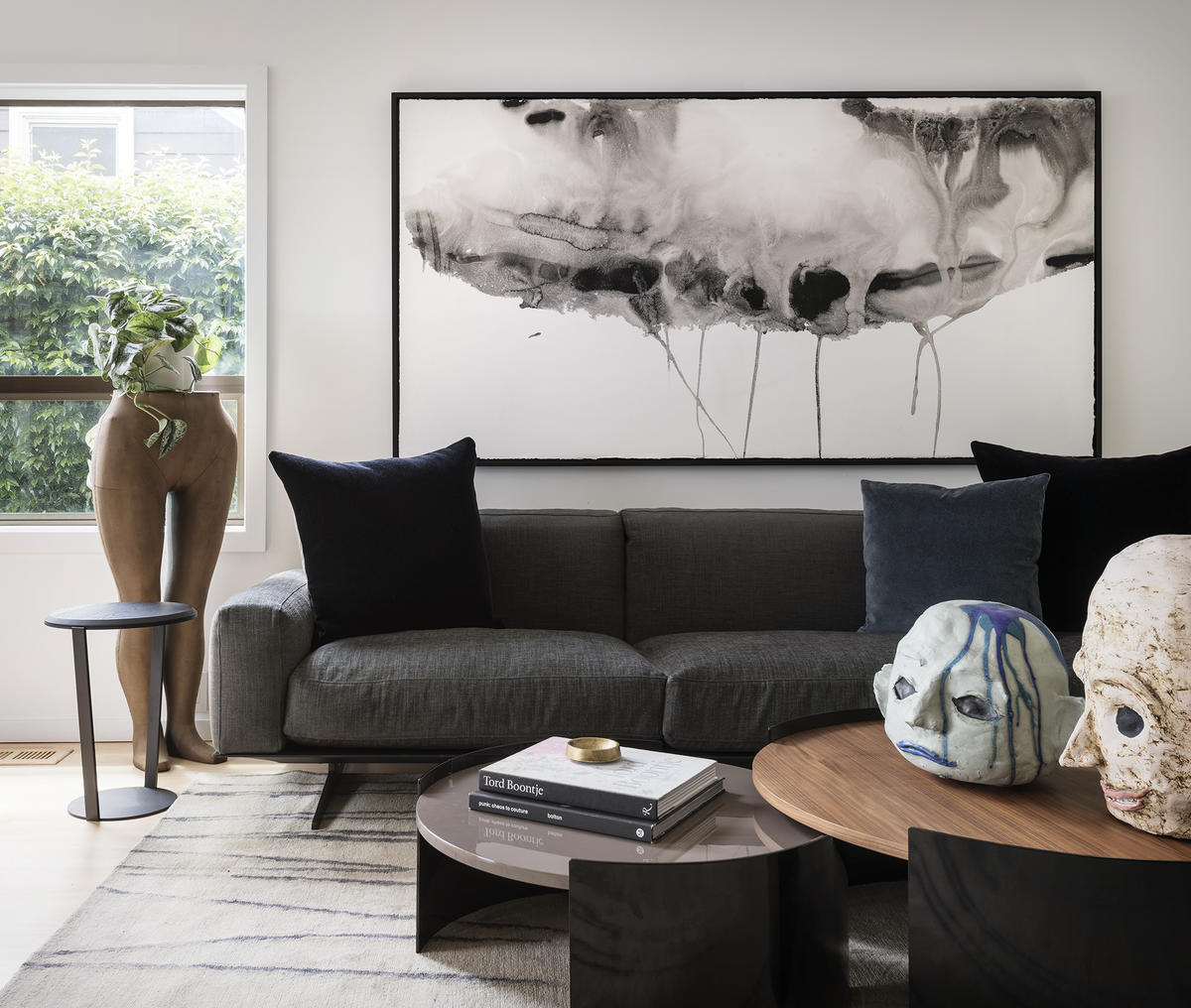
Tell me how and where you shop.
Everywhere. It would be my favorite if we could do almost exclusively vintage that we then customize. We’re not there yet, just because of time and availability, but we’re using [a mix of products] made in America, [by] independent makers, by small workshops, and then [those made by larger manufacturers, like] a B&B Italia sofa. A lot of our clients have a mix of high and low, especially for the kids’ bedroom.
We have a Seattle design center that carries the national brands. I primarily use it for fabric and wallpaper samples instead of spending hours online and guessing. A lot of the furniture [I source] is online from different cities, big and small. I like shopping with smaller companies. But again, it has to be the right client and price point. We don’t have a set rule or routine.
What are you seeing in Seattle, especially in the last year and a half or so?
The housing market is busy. Prices are going up. Every designer is busy, and one benefit of that is that designers are more open to talking about details with one another. I have a few different designers I can text, like, “Hey, I’m running into this—are you [seeing] it? This is what I’ve done. What did you do?” Then we’re able to share that information because everyone has enough work. I want to say that it would be like that no matter what, but my guess is that [the hot market] has to help.
What is the biggest thing you wish you had known when you were first starting your business?
Know when to say no. What no one talks about with that is that being able to say no is a big freedom. When you’re growing and afraid that you won’t have work, you don’t want to say no. When you’re supporting a team, you don’t want to have to lay someone off, and it’s a different pressure. But there have been projects where I’m like, “I should have just said no to that,” and it had a cascade effect of making some other stuff not feel great. But I feel like I’m in a place now where I can say no.
Have you changed the way you charge over time?
I’ve always charged per hour. My rate has gone up. I try to raise my rate every year. I don’t always, but I’m going to start being better about that.
Does that impact current clients or just new jobs?
New jobs are always at my new rate. In my contract, it says on the one-year anniversary of starting their project, we can raise it by 3 or 6 percent—I forget which—but the rate goes up to reflect inflation. When I first started out, for purchases, I used my designer price plus 20 percent, and I capped it at retail. I did that at first because I didn’t want clients shopping me, going out and buying it on their own. I was trying to cut out any incentives—because if I was charging my designer price at West Elm or something, and I already got like 10 percent or whatever, and then marked it up 20 percent, they’re paying above retail for an item, and that’s not great.
What changed for you?
One, I don’t have to shop at big chains as often; two, I’ve changed my contract. Now it’s the designer price plus 25 percent, and there isn’t a cap. We used to detail shipping and warehousing [costs] and all of that, and it took so long. Finally, we did enough audits and I talked with enough other designers that we just [decided to] charge 18 percent.
So 25 percent markup and 18 percent shipping and handling on that original amount?
Yes. And actually, we’ve continued to audit it because I’m curious if COVID will [require us] to charge more. It hasn’t yet, but I’m watching it. I’ve always had the client hire and pay the contractor directly. And I want them to purchase all of the major construction-related items, except what I call specialty items. So if I’m getting a beautiful chandelier from Lindsey Adelman, I don’t want a contractor doing it. But if I’m getting can lights in the room, here are the can lights I want—you please buy them.
Why is that split important to you?
Part of it is that I feel like contractors pay more attention when they have to buy something, and there’s more incentive because they want to get it right. So if something isn’t going to work, they notice if they’re buying it, and are more willing to speak up. Also, I want my client’s project to be appealing. And I know that contractors make money on markup as well. I want to make it a worthwhile project for them so that there are enough items for them to purchase on there. But the reason I would never give away the beautiful chandelier is because they’ll mess it up. It kind of also boils down to, like, independent places or ordering an item that’s going to take a lot of thought and back and forth—those items we should just take care of and not make the contractor have to open a new account with a bunch of places they’ve never heard of.
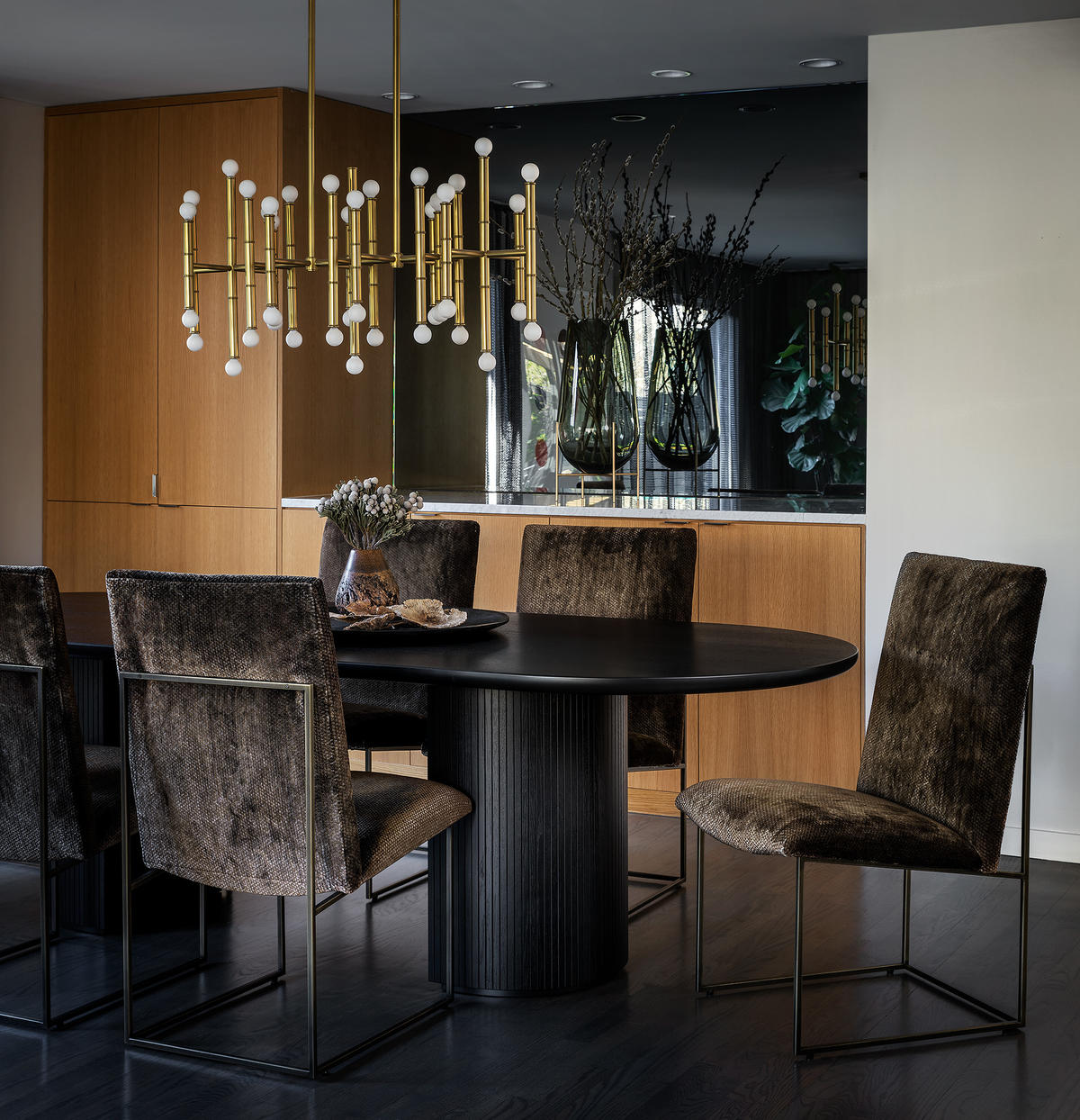
How have you approached social media, and is that a place where you’re getting clients?
I don’t think anyone is coming to me through Instagram, but I think it’s part of the package. So having a good Instagram feed is important. I don’t think it’s a strength of mine, and I’m trying to work on that. I think it’s because I don’t trust my own photography skills, but I also don’t want to just recycle the professional photos I have. I wish I was getting more people from across the country through Instagram.
I’m scrolling through your feed now, and I feel like there’s something very meditative about it. Users are seeing the same project, but also the same color palette through a trio of photos.
I started doing that because my projects were so different that my feed was looking really disjointed. So I started doing three photos in a row from the same project so that it felt [more cohesive]. I am now trying to think of how the color palette of each photo feeds into the next one. I’m trying to do six in a row, not at the same time, but like six days in a row, I’ll post photos from the same project. I don’t know if I’ll stick with that, but I felt like it helps to highlight the difference [between projects]. [When] you can see six modern photos together and six traditional photos together, it doesn’t look as messy.
There’s always something on the list of what to do next, social-media-wise. For me, that’s figuring out how to do Instagram Reels. For Stories, I’ll do personal stuff sometimes—like with my friends—but I would never post that [on my grid].
Was this always a business account, or was it a personal account first?
It started as a personal account, and I kept a few of those photos to show the progression. But I also archived a lot of those early personal posts.
What’s that transition like from person to brand?
I’ll say to my team or husband: “Michelle Dirkse the person thinks XYZ,” versus Michelle Dirkse the brand. I chose to have my name be a part of my firm name because I just felt like that’s how people search. If someone’s looking for me, I want to show up in their search results. At work, I definitely wear a different hat, and there are different sides of me at work versus outside. I think that’s one of the hard things—as [my business] grows, I feel like I’m supposed to put up more boundaries, and I don’t feel like I’m part of the team. Sometimes that doesn’t feel nice.
Are you at that point?
Yeah. I get along with everyone, and we have team happy hours, but I know I shouldn’t just be like, “Hey, want to go to happy hour?” I want to respect their boundaries. I think maybe those boundaries came with [my background in] social work. But we always have a great time. We have gone as a team to New York and L.A., and it’s so fun.
What’s the motivation behind those team trips?
It’s for inspiration, sourcing and fun. My team works really hard, and I want to have some nice bonus [experiences] that they hopefully like, but they’re never required to go. I took three team members—because that was the size of my team at the time—to ICFF in New York, and then to the La Cienega Design Quarter in L.A. We had tickets to go to San Francisco, but we had to cancel that because of COVID, and we haven’t done anything since then. It feels irresponsible as an employer to travel with the team for fun, because if something happened, it’s because of me. It’s just not worth it right now. That said, the team really does want to go do things. I think there will come a time when it’s like, “We want to photograph this project in New York,” so we’ll use that as the excuse to go there and have some fun and look at resources.
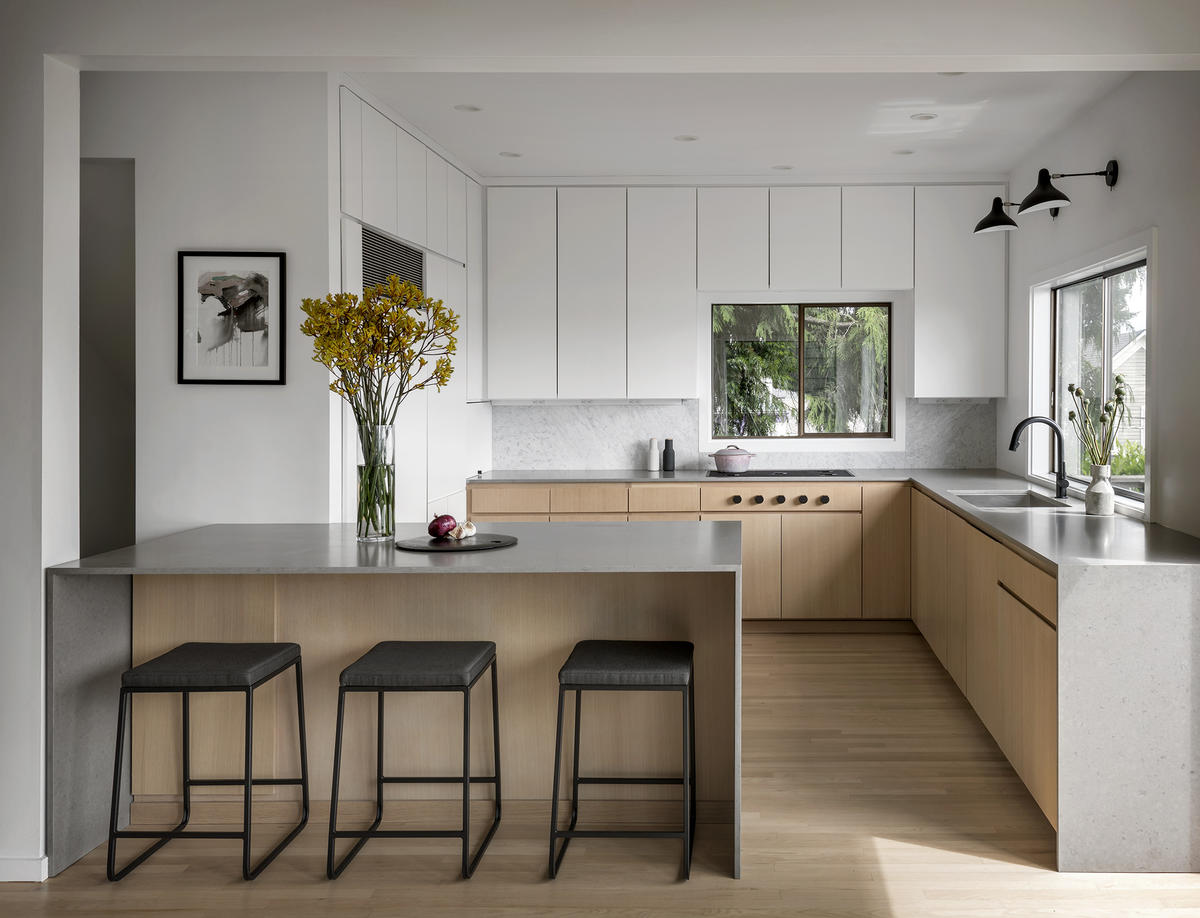
You mentioned boundaries, and it got me thinking about client management and boundaries. How much of your social work career comes into play there?
It’s hard to say, because part of why I was drawn to social work is because of the person I am. But I think whether it’s because of my social work background or the person I am, I listen for meaning. Don’t just listen to the words that people are saying, because sometimes they don’t know what they mean or they’re using the wrong words. I’m always trying to figure out what they really mean. There are a lot of conversations in the office where I’m like, “I know [the client] said to do that, but don’t do that. They’re going to change their mind in a week.”
And then they do.
Yes. The unexpected benefit of social work [experience] is the project management skills. In social work, there’s not enough money, and that means you’re overworked. I was managing 48 different clients as a case manager, and I kind of follow the same organizational systems for my client list now.
Oh, interesting. I would never have guessed that.
And billable hours too—how do you get the most out of your hours? How do you reflect the hard work you’re doing without cheating in any way?
Was figuring that out one of the biggest challenges?
That was one of them. I think they’re different every year, but my hardest challenge was [deciding] when to hire—and then at one point, I did have to lay someone off, and that was devastating.
Because of cash flow, or because it wasn’t a good fit?
I just didn’t have enough work. It was a dip, and I carried it for a bit, but then I was just like, “I don’t know how long this will last, so I have to lay you off.” That was really hard. But this year, my biggest challenge is that our lease was up and I bought us an office condo, which is great because now I’m not paying someone else; I’m paying my own mortgage. But also working with the SBA to get a business mortgage—it made it possible, but it is really hard.
What were the tricky parts?
I wanted to create another company that actually is the owner of the property to help protect my business. For example, let’s say someone falls on the sidewalk out front, and so they’re going to sue the owner, who’s supposed to take care of the sidewalk. They would sue my other company, not Michelle Dirkse Interior Design. So basically, I had to do every piece of paperwork four times because there’s the SBA loan and the regular portion that goes through the bank. I’m proud that it happened and I got through it.
How did that new space change the way your firm worked?
When you buy as a business instead of a homeowner, you can put 10 percent down for a commercial property, whereas normally, you have to put down 20 percent. That meant that I could actually tear out some walls once we got it. We moved over the summer, and it’s hard to say how it will change things, because we’re still working from home part-time. But it’s a mile from my house, and studies show that life balance and smaller commutes equal increased happiness. I am in a position where I can kind of control that, so I’m going to. I think it will just give me the freedom to invest in it and not worry about spending money on cabinets that someone else is going to get to use in five years.
Is your business today what you’d have imagined when you first started?
It’s more than what I imagined. When I first started, I was going to be happy if I was waitressing part-time the rest of my life and also had some clients. I gave myself the freedom to fail, and [I went from] thinking I would maybe have a client or two to having 50 projects a year and a team. I didn’t think that would ever be possible.
To learn more about Michelle Dirkse, visit her website or find her on Instagram.
Homepage photo: Michelle Dirkse | Aaron Leitz















